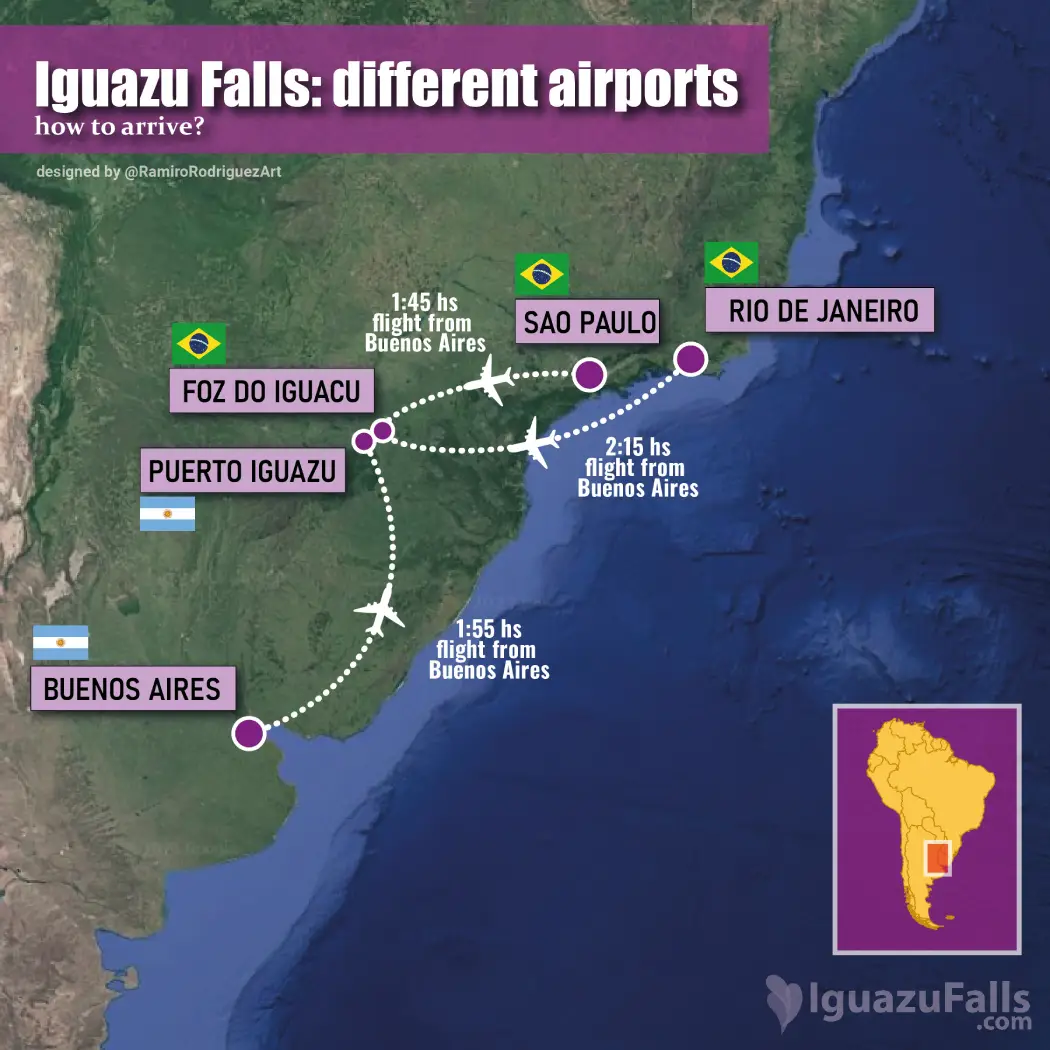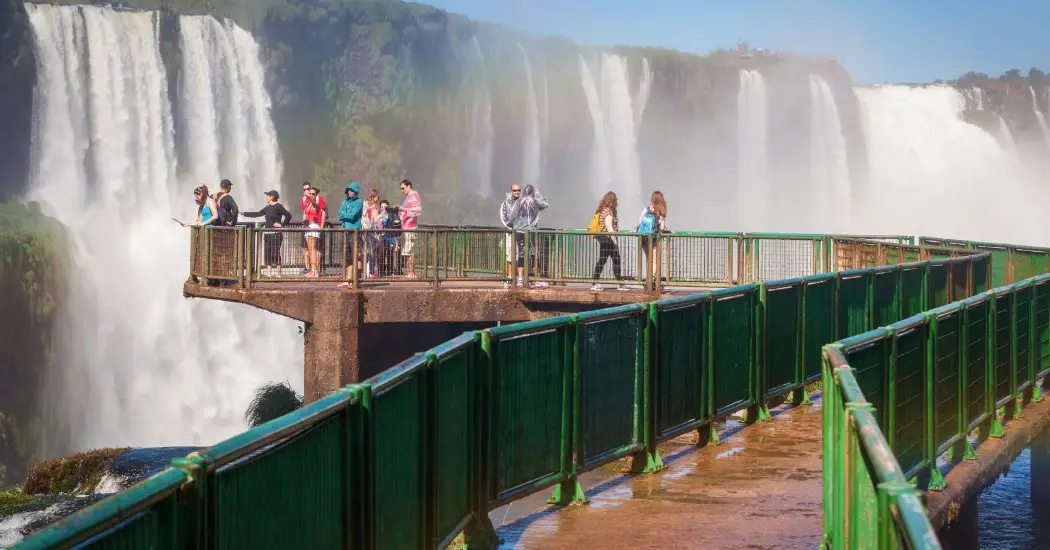How to get to Iguazu Falls
From Argentina, Brazil & Nearby Cities

Iguazu Falls is one of the world’s most impressive natural wonders, drawing millions of visitors each year.
But due to its remote jungle location in South America, many travelers wonder how exactly to get there.
This guide explains how to reach Iguazu Falls from major cities, such as Buenos Aires and Rio de Janeiro, as well as local towns like Puerto Iguazú and Foz do Iguaçu—whether you’re traveling by air, bus, car, or cross-border transfer, and from either Argentina or Brazil.
Choose between the Argentina side or Brazil side tours, or experience both in a full-day tour. For an extra thrill, add a Macuco Safari or Gran Aventura boat ride, or take a helicopter tour for breathtaking aerial views.
Where is Iguazu Falls located?

Iguazu Falls is located on the border of Argentina and Brazil, along the Iguazú River. It consists of two distinct national parks—Iguazú National Park in Argentina and Iguaçu National Park in Brazil. Get Directions
The nearest cities are Puerto Iguazú (Argentina) and Foz do Iguaçu (Brazil), both serving as main gateways for visitors.
How to get to Iguazu Falls from Puerto Iguazú (Argentina)
Puerto Iguazú is approximately 18 km (11 miles) from the Argentinian side of the Iguaza Falls.
Cataratas del Iguazú International Airport (IGR) in Argentina is about 10 km (6 miles) from the Argentinian park entrance.
By Bus
- Rio Uruguay buses run every 15–30 minutes from the town bus terminal to the national park.
- The ride takes about 30 minutes and costs around $5.50 one way.
- For early entry, catch the 7.30 am bus or earlier.
By taxi
- Taxis are easily accessible and cost around $20 to $25 for one way trip.
- There’s no Uber or Cabify in town. You can arrange a taxi through your hotel.
By tour
- Take a group tour or a private tour that includes transport from your hotel to the Iguazu Falls and back.
By car rental
- Costs range from $29 to $40 per day, depending on the vehicle and demand.
- Major providers include Avis, Hertz, Budget, Europcar, and Sixt, with pick-up points at IGR Airport and the town center.
How to get to Iguazu Falls from Foz do Iguaçu (Brazil)
Foz do Iguaçu is about 20 km (12 miles) from the Brazilian side of the Iguazu Falls.
Foz do Iguaçu/Cataratas International Airport (IGU) in Brazil is located just 3 km (2 miles) from the Brazilian park entrance.
By bus
- Bus (route 120) runs frequently from the Foz do Iguaçu main terminal and takes 20–30 minutes to reach the park’s visitor center. The fare is just over $1.
- This same bus also serves the airport.
By Uber/taxi
- Uber is available and costs about $10 for the 20-minute ride to the park entrance.
- However, getting an Uber back from the park can be tricky due to weak signals and limited drivers.
- Taxis and airport shuttles are reliable alternatives.
By car rental
- You can rent a car at Foz do Iguaçu Airport for around $18 to $35 per day, depending on timing and availability.
- Major rental companies include Localiza, Unidas, Movida, Avis, Budget, etc.
By guided tour
- In tours such as day tours and private tours, transportation is included, with pick-up and drop-off at your hotel.
Book a private transfer for a more comfortable ride with 24/7 support—perfect for cross-border trips or group travel
How to get to Iguazu Falls from Buenos Aires (Argentina)
By flight
- From Aeroparque Jorge Newbery (AEP) to Cataratas del Iguazú Airport (IGR), it takes around 2 hours and costs around $35 one way.
- Airlines like Aerolineas Argentinas and JetSMART operate this route.
- From IGR, it’s a 25-minute drive to the national park by taxi, shuttle, or hotel transfer.
By bus
- Budget travelers can take an overnight bus from Retiro Bus Terminal in Buenos Aires to Iguazu Falls.
- The journey takes around 18–20 hours and costs between $60 and $130, which might be more expensive than flying.
By car
- You can drive from Buenos Aires to Iguazu Falls, but it’s a long journey of over 1,300 km (808 miles), taking about 16–18 hours.
- It’s best suited for road trip lovers with plenty of time.
How to get to Iguazu Falls from Rio de Janeiro or São Paulo
By flight
- The fastest way to reach Iguazu Falls from Rio de Janeiro or São Paulo is by flying to Foz do Iguaçu International Airport (IGU).
- Flights take around 2 hours from Rio and 1.5 hours from São Paulo, with airlines like LATAM, Gol, and Azul operating regularly.
- From the airport, it’s about a 20-minute drive to Iguaçu National Park.
By bus
- A cheaper but much longer option is to travel by bus, which takes about 18 to 24 hours.
- Buses depart from Novo Rio Terminal in Rio or Tietê Terminal in São Paulo.
Crossing the border between Argentina and Brazil
- Want to see both sides of the falls? You’ll need to cross the Tancredo Neves International Bridge.
- To cross the border between Argentina and Brazil, you’ll need a passport and a visa if your nationality requires one.
- The process takes 1 to 2 hours, including immigration.
- Taxis, shuttle vans, and guided or private tours often assist with the crossing and required documentation.
- The border is open from early morning to late evening, making same-day crossings possible.
- Most travelers from Europe, North America, and Oceania can visit Brazil and Argentina visa-free for up to 90 days (Check the latest visa requirements.)
Note: U.S., Canadian, and Australian citizens need a printed Brazil e-visa and a valid passport. Digital copies are not accepted. If you are re-entering Argentina, ensure your visa allows for multiple entries.
Frequently Asked Questions
Here are some questions tourists ask about how to get to the Iguazu Falls.
Can I rent a car to get to Iguazu Falls?
Yes, you can rent a car on either side of Iguazu Falls. Rentals start around $30 to $40 per day, and major companies are available at both IGR (Argentina) and IGU (Brazil).
Is it safe to cross the border?
Yes, it’s safe to cross the border between Argentina and Brazil at Iguazu Falls. Most tourists use taxis or guided transfers, which handle the immigration process smoothly. Just keep your passport and visa (if required) handy, and avoid crossing late at night.
Which side is easier to reach the Iguazu Falls—Argentina or Brazil?
The Brazilian side (Foz do Iguaçu) is generally easier to reach due to more frequent flights and a larger airport (IGU). However, if you’re already in Argentina, the Argentina side (Puerto Iguazú) is very accessible with a short drive from the IGR airport. It depends on where you’re starting from.
Do I need a visa to cross between Argentina and Brazil?
It depends on your nationality. Many tourists (EU, US, UK) can cross with just a passport, but always check before traveling.
Is public transport reliable in Puerto Iguazú or Foz do Iguaçu?
Yes, public transport is reliable in both Puerto Iguazú and Foz do Iguaçu. Regular buses run to the national parks every 15–30 minutes and are affordable. They’re a convenient option, though taxis or tours offer more flexibility.
Key travel tips to visit Iguazu Falls

Duration of visit
- Argentina Side: Set aside one full day, or 2 days to enjoy all circuits (Upper, Lower, Devil’s Throat) and boat tours without rushing.
- Brazil Side: Allow at least 2–3 hours for viewpoints, or more if adding a safari, boat, or helicopter tour.
What to pack
- Clothing: Quick-dry clothes and shoes that can get wet. Avoid white shoes (red dirt stains).
- Footwear: Hiking sandals or walking shoes with grip.
- Protection: Sunscreen, sunglasses, hat, insect repellent.
- Gear: Daypack, reusable water bottle, phone lanyard, waterproof case, power bank.
Wildlife interactions
- Expect to see coatis, monkeys, butterflies, lizards, and possibly toucans.
- Do not feed or touch animals—they can bite, scratch, and may carry diseases.
Currency & payments
- Argentina may offer better rates with USD exchanged at the blue dollar rate.
- Carry both ARS and BRL in cash, as cards aren’t accepted everywhere.
Vaccinations
- Recommended: Yellow fever (especially for Brazil), Hepatitis A, Typhoid
- No malaria risk, but mosquito repellent is essential to prevent dengue.
